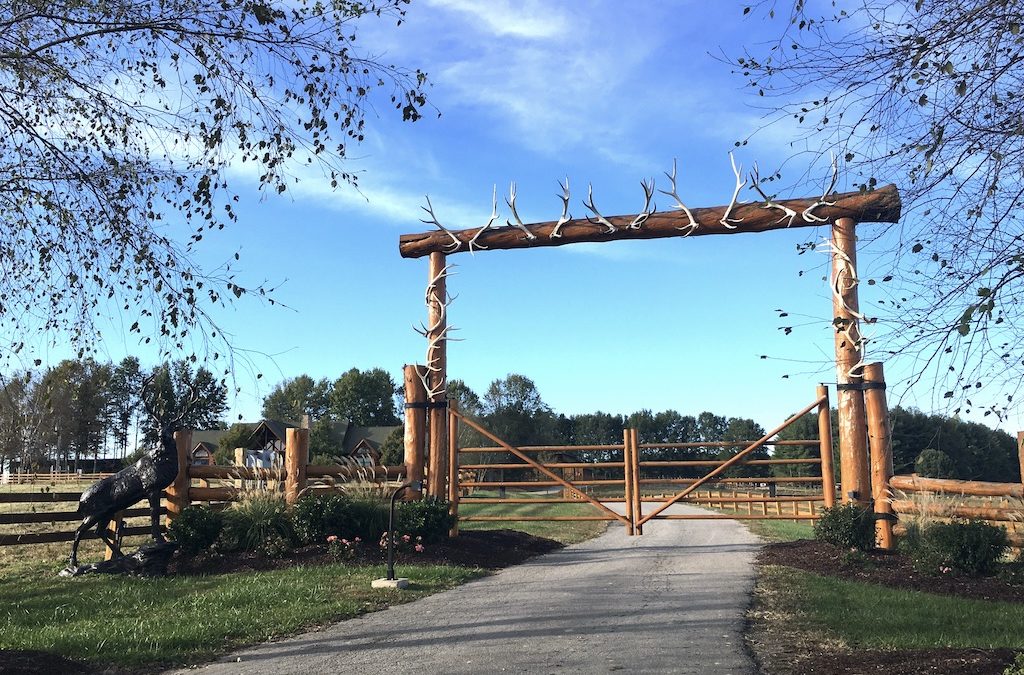People build fencing for a variety of reasons. The motivation behind the fence also gives us ideas about the materials that would be best for you.
If the fence is purely utilitarian, such as protecting a parking lot at an industrial site or to keep a dog corralled in a yard, the material used need to be sturdy and tall but maybe not decorative.
The Honest Abe Log Home pictured above belongs to one of Honest Abe’s owners, Shane Smith. His fencing is decorative as well as utilitarian.
A fence that is decorative might be wood, but wood requires periodic cleaning and sealing to maintain. For those who do not want the extra upkeep, aluminum, wrought iron, steel or a wood-look vinyl may be better solutions. Fencing materials can be mixed. You may find that a more expensive material could be used at the front of the property with chain link at a tree line where it is not as visible.
Privacy Fencing Styles
Privacy is the most common reason people have for wanting to build a fence.
Some of the most popular privacy fence styles include:
- Board and Batten Fence
- Vertical Board Fence
- Stockade Fencing
Semi-Private Fence Styles
Semi-private fencing allows air to flow through and stands up well to wind. Since semi-private fences look the same from both sides, they are often referred to as “good neighbor fences.”
Popular semi-private fencing styles:
- Wyngate Fence
- Picket Fence Styles
- Picket fence styles lend charm and beauty.
Some of the most popular picket fence styles include:
- Wood Picket Fencing
- Vinyl Picket Fencing
- Ornamental Fencing
Post & Rail Fence Styles
Post and rail fence is an open style of fence that offers high visibility and a rustic feel. It is often used to fence in larger animals but can also be designed with mesh components to keep smaller pets from slipping through the open rails.
Some of the post and rail fence styles we offer include:
- Split Rail Fence
- Estate Fencing
- Paddock Fence
Swimming Pool Fencing Styles
Swimming pool fencing must meet state and local codes. In most states these include requirements for not more than 2 inches from the ground, at least 48 inches tall, a self-closing positive lock on the gate that is at least 45 inches above ground, no areas of the fencing that can be used to climb the fence and being 36 inches from the edge of the pool.
Pet Fence Styles
Many people choose custom pet fencing styles to keep their pets safe from other animals or from passing cars. Open rail fencing can be used with small animals when mesh is added
Questions to Ask Before You Start Your Fence
Fencing adds security, privacy and curb appeal to a residential or commercial property. Before the project can begin there are a few construction issues that will need to be answered:
Are there neighborhood or community guidelines or codes that control the materials, height or placement of the fencing or gates?
Where are your property lines? A fence built on the property line will never belong to you regardless of the fact that you paid to construct it.
Are there any set-back requirements for a fence in the neighborhood covenants or in local codes.
Are there any creeks or streams that the fence will cross that may require special permitting from the county’s stormwater office?
Where are the water, electrical, gas phone or cable lines that may be buried along where the fence line is to go?
Article courtesy of Sands Fence Company LLC.




